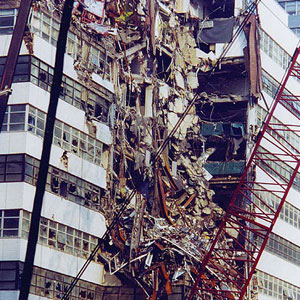
What does Ground Zero mean?
Should the boundaries of 9/11 devastation be solely contained within a single continuous chain link fence in Lower Manhattan?
ground zero
— n
1. a point on the surface of land or water at or directly above or below the center of a nuclear explosion
2. a scene of great devastation
Before Ground Zero earned its capital letters and became the defacto term for the area of the NYC terrorist attacks on 9/11, it simply meant “a scene of great devastation.”
Throughout their existence, the Twin Towers were one of the most revered architectural skyscrapers of their time. Millions flocked to the 110-story observation deck to take pictures, buy t-shirts and mementos. Post 9/11, tourists still flocked to the area: a grotesquely different view that could no longer be called the Twin Towers. “Ground Zero” was a different word for a much-changed, different place.
There has been a lot of discussion about what should be considered “Ground Zero.” Putting definitive boundaries is a slippery slope. Here is a list of buildings that were affected by the terrorist attacks on 9/11.
The World Trade Center and its buildings:
1 World Trade Center
2 World Trade Center
3 World Trade Center – Marriott (Former Vista Hotel)
4 World Trade Center
5 World Trade Center
6 World Trade Center
7 World Trade Center

Other buildings/structures destroyed or damaged on 9/11:
90 West Street
St. Nicholas Orthodox Greek Church
1 Liberty Plaza Building
Millenium Hotel
Old Post Office Building
BMCC/CUNY Fitterman Hall
Verizon Building
Bankers Trust Building
World Financial Center Bridge
World Financial Center Winter Garden
American Express Building
Merill Lynch Building
Gateway Plaza Complex
The building which endured damage furthest North of the Twin Towers footprints is the Borough of Manhattan Community College’s Fitterman Hall. The building at 30 West Broadway was destroyed by the collapse of 7 World Trade Center on 9/11. Today, the boundaries of the now demolished building, is not considered “Ground Zero.” Although, from the site of the proposed Park51 center, you can look West at the site where the building used to be. Is it that we implicitly feel the destruction of the CUNY building isn’t part of the boundaries of devastation?
Here is a Google Map look on the corner of West Broadway and Park Place. From a simple turn on the corner you can see the former Fitterman Hall and the former Burlington Coat Factory.

To limit the term “Ground Zero” to the footprints of the Twin Towers automatically diminishes any destruction suffered on 9/11 beyond the chain linked fence that exists today.
To set boundaries means that insensitivities can be easily hurled from both sides of the Park51 debate. Like a game of tag, using the term Ground Zero is tantamount to having a “base” or “being safe.” Is it though?
The term “Ground Zero” should not be leveraged on either side to discuss who is right and who is wrong.
Residents of Battery Park City who were displaced and had to flee the neighborhood because of air and water concerns are also victims of the events that occurred at Ground Zero — although hardly recognized as such.  Many residents did not have homes to return to that day, could not return until their buildings were deemed safe. Devastation of businesses, houses of worship and homes were widespread in areas not colloquially considered “Ground Zero.” Does that make their experience post 9/11 any less important or less part of that scene?
To limit “Ground Zero” — which generically means “a scene of great devastation” — to just the footprints of the Twin Towers is a great disheartenment and disservice to the survivors of the attacks: the residents, businesses, schools and those who have endured to rebuild this community. Just ask anyone who lived in Battery Park City at that time. If the Cordoba Initiative wants to be part of the rebuilding, acknowledging instead of denying they are a community center at “Ground Zero” would be a first step in a good direction. Wouldn’t it be an honor to be part of rebuilding Ground Zero? After 9 years of almost inaction at the site, anyone who wants to improve on our community should be welcomed.
Perhaps the next step is to teach America and beyond that “Islam,””Muslims” and “mosque” are not dirty words.
Islam, Muslim, and mosque may not be dirty words, but to America they represent a devestation to this country that has never taken place before and I pray to God never will again. As Christians, we try to spread the word of God and help all corners of the world. Sometimes people confuse religion with denominations; anyone can be any denomination IN CHRIST they wish to be, that is our freedom. Muslim is not in CHRIST. Muslim is a religion that is against Jesus, God and therefore, not welcomed in a Christian world. The United States was formed as a CHRISTIAN NATION and I believe should stay that way. Freedom of religion by our forefathers, I believe, meant freedom of denomination. That is my opinioon and last I heard, I have the freedom to have my own opinion.